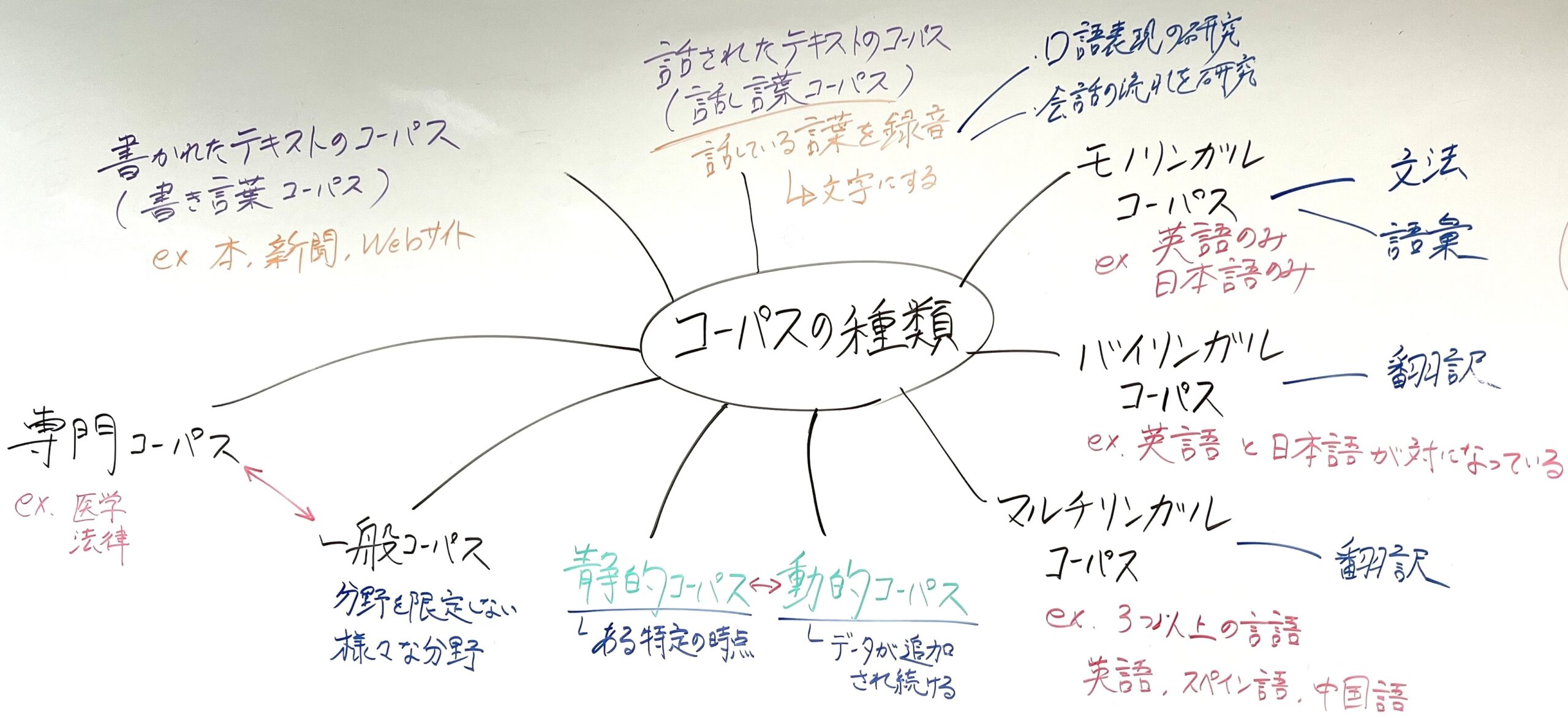コーパスとは、言語学や言語教育、自然言語処理などで使用される、大量のテキストや発話データを集めたものです。コーパスを使うことで、言語の使い方を詳しく分析できたり、コンピュータに言語を理解させる手助けをすることができます。今回は、コーパスのいろいろな種類について説明します。
A corpus is a collection of large amounts of text and speech data used in linguistics, language education, and natural language processing. By using corpora, we can analyze language usage in detail and help computers understand language.
モノリンガルコーパス、バイリンガルコーパス、マルチリンガルコーパス
Monolingual corpus, bilingual corpus, and multilingual corpus
- モノリンガル(単一言語)コーパス
- これは一つの言語だけを集めたコーパスです。例えば、英語の新聞記事だけを集めたり、日本語の小説だけを集めたりすることがあります。このコーパスは、その言語の文法や語彙を詳しく研究するのに使われます。
- Monolingual (single language) corpus
- This is a corpus that contains only one language. For example, one might collect only English newspaper articles or only Japanese novels. This corpus is used to study the grammar and vocabulary of the language in detail.
- バイリンガル(二言語)コーパス
- 二つの異なる言語のテキストが対になっているコーパスです。例えば、日本語の文とそれに対応する英語の文がセットになっているものです。このタイプのコーパスは、特に翻訳の研究や言語間の比較に役立ちます。
- Bilingual (two-language) corpus
- A corpus that contains pairs of texts in two different languages. For example, a set of Japanese sentences and their English counterparts. This type of corpus is especially useful for translation research and interlanguage comparisons.
- マルチリンガル(多言語)コーパス
- 三つ以上の異なる言語を含むコーパスです。例えば、英語、スペイン語、中国語の文がそれぞれ対応しているコーパスもあります。この種のコーパスは、多言語間での翻訳システムの開発などに利用されます。
- Multilingual (multilingual) corpus
- A corpus that contains three or more different languages. For example, some corpora have English, Spanish, and Chinese sentences corresponding to each other. This type of corpus is used, for example, to develop multilingual translation systems.
専門的コーパス、一般コーパス、静的コーパス、動的コーパス
Specialized corpus, general corpus, static corpus, dynamic corpus
- 専門的コーパス
- 特定の分野や専門領域に関連する言語のデータを集めたコーパスです。例えば、医学関連の専門用語や法律文書のコーパスがあります。これを使うことで、その分野特有の言葉や表現を理解することができます。
- Specialized corpus
- A corpus is a collection of linguistic data related to a specific field or area of expertise. For example, there are corpora for medical terminology and legal documents. By using this, you can understand the language and expressions specific to the field.
- 一般コーパス
- 特定の専門分野に限定されず、日常的に使われるさまざまな言語のデータを含むコーパスです。新聞、雑誌、ウェブサイトのテキストなどが含まれます。
- General corpus
- A corpus that is not limited to a specific field of expertise, but contains data on a variety of languages used in everyday life. It includes texts from newspapers, magazines, websites, etc.
- 静的コーパス
- ある特定の時点で集められた言語データを固定して保持するコーパスです。このデータは更新されず、研究で一定の基準として使われることが多いです。
- Static corpus
- A corpus that holds a fixed set of linguistic data collected at a particular point in time. This data is not updated and is often used as a constant reference in research.
- 動的コーパス
- 時間が経つにつれて新しいデータが追加され続けるコーパスです。言語の変化や新しい言葉の使い方を研究するのに適しています。
- Dynamic corpus
- This is a corpus to which new data is continually added over time. It is suitable for studying language change and new language usage.
書かれたテキストと話されたテキストのコーパス
Corpus of written and spoken texts
- 書かれたテキストのコーパス
- 本、新聞、ウェブサイトなど、書かれた形で存在するテキストのデータを集めたコーパスです。書かれた言語の特徴や構造を分析するのに使われます。
- Corpus of Written Texts
- This corpus collects data on texts that exist in written form, such as books, newspapers, and websites. It is used to analyze the characteristics and structure of written language.
- 話されたテキストのコーパス
- 人々が実際に話している言葉を録音し、文字に起こしたものです。このコーパスは、口語的な表現や会話の流れを研究するのに役立ちます。
- Corpus of Spoken Texts
- These are recordings of words actually spoken by people and transcribed into written form. These corpora are useful for studying colloquial expressions and conversational flow.
これらのコーパスは、言語のさまざまな側面を研究するための重要なツールです。それぞれが持つ特性を理解することで、より効果的に言語の学習や研究が行えます。
These corpora are important tools for studying different aspects of language. By understanding the characteristics of each, we can learn and study language more effectively.
メモリーツリー(Memory Tree)

問題
1. モノリンガルコーパスとは何ですか?
2. バイリンガルコーパスの利用例を一つ挙げてください。
3. マルチリンガルコーパスには何が含まれていますか?
4. 専門的コーパスとはどのようなコーパスですか?
5. 一般コーパスと専門的コーパスの違いは何ですか?
6. 静的コーパスとはどのような特徴を持つコーパスですか?
7. 動的コーパスの特徴は何ですか?
8. 書かれたテキストのコーパスとは何を集めたものですか?
9. 話されたテキストのコーパスにはどのようなデータが含まれていますか?
10. マルチリンガルコーパスが使われる例を挙げてください。
1. What is a monolingual corpus?
2. Give one example of the use of a bilingual corpus.
3. What does a multilingual corpus contain?
4. What is a specialized corpus?
5. What is the difference between a general corpus and a specialized corpus?
6. What are the characteristics of a static corpus?
7. What are the characteristics of a dynamic corpus?
8. What is a corpus of written texts?
9. What data does a corpus of spoken texts contain?
10. Can you give an example of a multilingual corpus in use?
答え
1. モノリンガルコーパスは、一つの言語だけを集めたコーパスです。
2. バイリンガルコーパスは、翻訳の研究や言語間の比較に利用されます。
3. マルチリンガルコーパスには、三つ以上の異なる言語が含まれます。
4. 専門的コーパスは、特定の分野や専門領域に関連する言語のデータを集めたものです。
5. 一般コーパスは特定の専門分野に限定されずに使用され、専門的コーパスは特定の分野の専門用語やデータが含まれます。
6. 静的コーパスは一定の時点で集められ、その後更新されないコーパスです。
7. 動的コーパスは時間が経つにつれて新しいデータが追加されるコーパスです。
8. 書かれたテキストのコーパスは、本や新聞、ウェブサイトなど書かれた形のテキストを集めたものです。
9. 話されたテキストのコーパスは、実際に話された言葉を録音し、文字に起こしたデータが含まれています。
10. マルチリンガルコーパスは、多言語間での翻訳システムの開発に利用されます。
1. A monolingual corpus is a corpus of only one language.
2. A bilingual corpus is used for translation studies and comparisons between languages.
3. A multilingual corpus contains three or more different languages.
4. A specialized corpus is a collection of data on languages related to a specific field or area of expertise.
5. A general corpus is used without being limited to a specific field of expertise, while a specialized corpus contains terminology and data from a specific field.
6. A static corpus is a corpus that is collected at a certain point in time and is not updated thereafter.
7. A dynamic corpus is a corpus to which new data is added over time.
8. A written text corpus is a collection of texts in written form, such as books, newspapers, websites, etc.
9. A corpus of spoken texts contains data from recordings and transcriptions of actual spoken words.
10. Multilingual corpora are used to develop translation systems between multiple languages.

